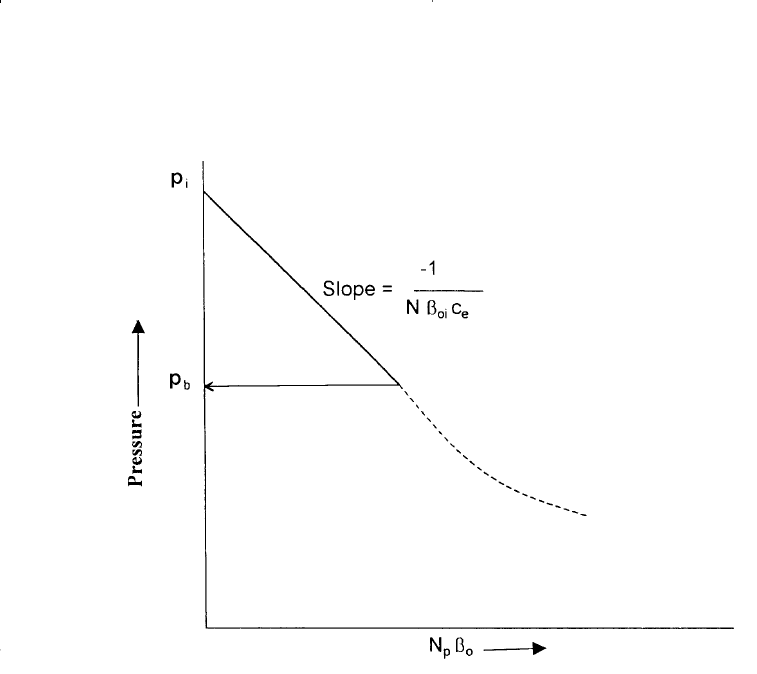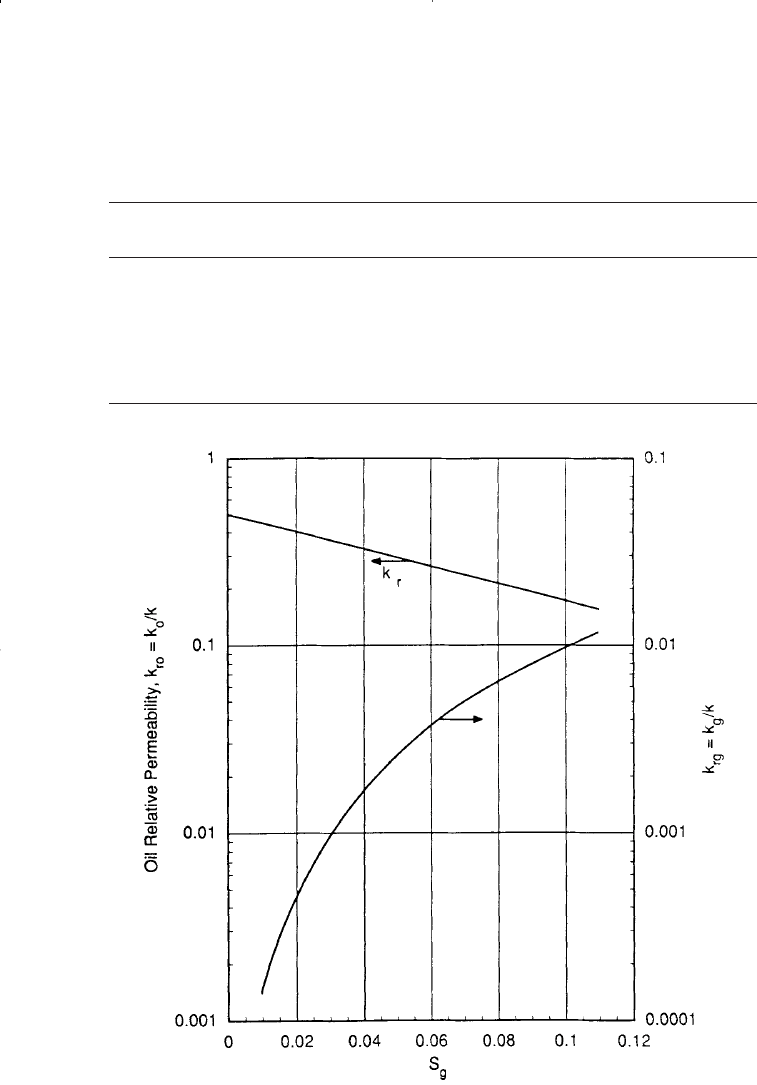Tarek Ahmed. Reservoir engineering handbook
Подождите немного. Документ загружается.


m = 0
W
e
= 0
R
s
= R
si
= R
p
Imposing the above conditions on the MBE reduces the equation to the
following simplified form:
with
∆p = p
i
− p
where p
i
= initial reservoir pressure
p = current reservoir pressure
Hawkins (1955) introduced the oil compressibility c
o
into the MBE to
further simplify the equation. The oil compressed is defined in Chapter
2 by:
rearranging, gives:
B
o
− B
oi
= c
o
B
oi
∆p
Combining the above expression with Equation 12-26 gives:
The denominator of the above equation can be written as:
N
NB
cB p B
Sc c
S
p
po
ooi oi
wi w f
wi
=
+
+
−
∆∆
1
(12 - 27)
c
B
BB
p
o
oi
ooi
=
−
1
∆
N
NB
BB B
Sc c
S
p
po
ooi oi
wi w f
wi
=
−+
+
−
()
1
∆
(12 - 26)
798 Reservoir Engineering Handbook
Reservoir Eng Hndbk Ch 12 2001-10-25 16:04 Page 798

Since there are only two fluids in the reservoir, i.e., oil and water, then:
S
oi
+ S
wi
= 1
Equation 12-28 can then be expressed as:
The term between the two brackets is called the effective compress-
ibility and defined by Hawkins (1955) as:
Combining Equations 12-27, 12-28, and 12-29, the MBE above the
bubble-point pressure becomes:
Equation 12-30 can be expressed as an equation of a straight line by:
Figure 12-6 indicates that the reservoir pressure will decrease linearly
with cumulative reservoir voidage N
p
B
o
.
Rearranging Equation 12-31 and solving for the cumulative oil pro-
duction N
p
gives:
NNc
B
B
p
pe
o
oi
=
∆ (12 - 32)
PP
NB c
NB
i
oi e
po
=−
1
(12 - 31)
N
NB
Bc p
NB
Bc P P
(12 - 30)
po
oi e
po
oi e i
==
−
()
∆
c
Sc S c c
S
e
oi o wi w f
wi
=
++
−1
(12 - 29)
B
Sc S c c
1S
p
oi
oi o wi w f
wi
++
−
∆
Bc
Sc
S
c
S
p
oi o
wi w
wi
f
wi
+
−
+
−
11
∆ (12 - 28)
Predicting Oil Reservoir Performance 799
Reservoir Eng Hndbk Ch 12 2001-10-25 16:04 Page 799

The calculation of future reservoir production, therefore, does not
require a trial-and-error procedure, but can be obtained directly from the
above expression.
Example 12-3
The following data are available on a volumetric undersaturated-oil
reservoir:
p
i
= 4000 psi p
b
= 3000 psi N = 85 MMSTB
c
f
= 5 × 10
−6
psi
−1
c
o
= 15 × 10
−6
psi
−1
c
w
= 3 × 10
−6
psi
−1
S
wi
= 30% B
oi
= 1.40 bbl/STB
Estimate cumulative oil production when the reservoir pressure drops
to 3500 psi. The oil formation volume factor at 3500 psi is 1.414
bbl/STB.
800 Reservoir Engineering Handbook
Figure 12-6. Pressure voidage relationship.
Reservoir Eng Hndbk Ch 12 2001-10-25 16:04 Page 800

Solution
Step 1. Determine the effective compressibility from Equation 12-29.
Step 2. Estimate N
p
from Equation 12-32.
Saturated-Oil Reservoirs
If the reservoir originally exists at its bubble-point pressure, the reser-
voir is referred to as a saturated-oil reservoir. This is considered as the
second type of the solution-gas-drive-reservoir. As the reservoir pressure
declines below the bubble-point, the gas begins to evolve from solution.
The general MBE may be simplified by assuming that the expansion of
the gas is much greater than the expansion of rock and initial water and,
therefore, can be neglected. For a volumetric and saturated-oil reservoir
with no fluid injection, the MBE can be expressed by:
The above material balance equation contains two unknowns, which are:
• Cumulative oil production N
p
• Cumulative gas production G
p
The following reservoir and PVT data must be available in order to
predict the primary recovery performance of a depletion-drive reservoir
in terms of N
p
and G
p
:
a. Initial oil-in-place N
Generally the volumetric estimate of in-place oil is used in calculating
the performance. Where there is sufficient solution-gas-drive history,
N
NB G NR B
BB R RB
po p ps g
ooi sisg
=
+−
−+−
()
()()
(12 - 33)
N
MSTB
p
=× ×
−
=
−−
()(.)
.
.
()
.
85 10 23 43 10
1 411
1 400
4000 3500
985 18
66
c
psi
e
=
×+ ×+×
−
=×
−−−
−−
(.)( ) (.)( )
.
.
0 7 15 10 0 3 3 10 5 10
103
23 43 10
666
61
Predicting Oil Reservoir Performance 801
Reservoir Eng Hndbk Ch 12 2001-10-25 16:04 Page 801

however, this estimate may be checked by calculating a material-bal-
ance estimate.
b. Hydrocarbon PVT data
Since differential gas liberation is assumed to best represent the condi-
tions in the reservoir, differential laboratory PVT data should be used
in reservoir material balance. The flash PVT data are then used to con-
vert from reservoir conditions to stock-tank conditions.
If laboratory data are not available, reasonable estimates may some-
times be obtained from published correlations. If differential data are
not available, the flash data may be used instead; however, this may
result in large errors for high-solubility crude oils.
c. Initial fluid saturations
Initial fluid saturations obtained from a laboratory analysis of core
data are preferred; however, if these are not available, estimates in
some cases may be obtained from a well-log analysis or may be
obtained from other reservoirs in the same or similar formations.
d. Relative permeability data
Generally, laboratory-determined k
g
/k
o
and k
ro
data are averaged to
obtain a single representative set for the reservoir. If laboratory data
are not available, estimates in some cases may be obtained from other
reservoirs in the same or similar formations.
Where there is sufficient solution-gas-drive history for the reservoir,
calculate (k
rg
/k
ro
) values versus saturation from Equations 12-15 and
12-17, i.e.:
S
o
= (1 − S
wi
) (1 − N
p
/N) (B
o
/B
oi
)
k
rg
/k
ro
= (GOR − R
s
) (µ
g
B
g
/µ
o
B
o
)
The above results should be compared with the averaged laboratory
relative permeability data. This may indicate a needed adjustment in
the early data and possibly an adjustment in the overall data.
All the techniques that are used to predict the future performance of a
reservoir are based on combining the appropriate MBE with the instanta-
neous GOR using the proper saturation equation. The calculations are
repeated at a series of assumed reservoir pressure drops. These calcula-
tions are usually based on one stock-tank barrel of oil in place at the bub-
802 Reservoir Engineering Handbook
Reservoir Eng Hndbk Ch 12 2001-10-25 16:04 Page 802

ble-point pressure, i.e., N = 1. This avoids carrying large numbers in the
calculation procedure and permits calculations to be made on the basis of
the fractional recovery of initial oil in place.
There are several widely used techniques that were specifically devel-
oped to predict the performance of solution-gas-drive reservoirs, including:
• Tracy’s method
• Muskat’s method
• Tarner’s method
These methodologies are presented below.
Tracy’s Method
Tracy (1955) suggests that the general material balance equation can
be rearranged and expressed in terms of three functions of PVT vari-
ables. Tracy’s arrangement is given in Chapter 11 by Equation 11-53 and
is repeated here for convenience:
N = N
p
Φ
o
+ G
p
Φ
g
+ (W
p
B
w
− W
e
) Φ
w
(12 - 34)
where Φ
o
, Φ
g
, and Φ
w
are considered PVT-related properties that are
functions of pressure and defined by:
with
Den B B R R B m B
B
B
ooi sisg oi
g
gi
=−
(
)
+−
(
)
+−
1 (12 - 35)
Φ
w
1
Den
=
Φ
g
B
Den
g
=
Φ
o
=
−BRB
Den
osg
Predicting Oil Reservoir Performance 803
Reservoir Eng Hndbk Ch 12 2001-10-25 16:04 Page 803

For a solution-gas-drive reservoir, Equations 12-34 and 12-35 are
reduced to the following expressions, respectively:
N = N
p
Φ
o
+ G
p
Φ
g
(12 - 36)
and
Den = (B
o
− B
oi
) + (R
si
− R
s
) B
g
(12 - 37)
Tracy’s calculations are performed in series of pressure drops that pro-
ceed from known reservoir condition at the previous reservoir pressure p*
to the new assumed lower pressure p. The calculated results at the new
reservoir pressure become “known” at the next assumed lower pressure.
In progressing from the conditions at any pressure p* to the lower
reservoir pressure p, consider that the incremental oil and gas production
are ∆N
p
and ∆G
p
, or:
N
p
= N
*
p
+∆N
p
(12 - 38)
G
p
= G
*
p
+∆G
p
(12 - 39)
where N
*
p
, G
*
p
= “known” cumulative oil and gas production at
previous pressure level p*
N
p
, G
p
= “unknown” cumulative oil and gas at new pressure
level p
Replacing N
p
and G
p
in Equation 12-36 with those of Equations 12-38
and 12-39 gives:
N = (N
*
p
+∆N
p
) Φ
o
+ (G
*
p
+∆G
p
) Φ
g
(12 - 40)
Define the average instantaneous GOR between the two pressure p*
and p by:
The incremental cumulative gas production ∆G
p
can be approximated
by Equation 12-7 as:
∆G
p
= (GOR)
avg
∆N
p
(12 - 42)
()
*
GOR
GOR GOR
avg
=
+
2
(12 - 41)
804 Reservoir Engineering Handbook
Reservoir Eng Hndbk Ch 12 2001-10-25 16:04 Page 804

Replacing ∆G
p
in Equation 12-40 with that of 12-41 gives:
N = [N
*
p
+∆N
p
] Φ
o
+ [G
*
p
+∆N
p
(GOR)
avg
] Φ
g
(12 - 43)
If Equation 12-43 is expressed for N = 1, the cumulative oil produc-
tion N
p
and cumulative gas production G
p
become fractions of initial oil
in place. Rearranging Equation 12-43 gives:
Equation 12-44 shows that there are essentially two unknowns, the
incremental cumulative oil production ∆N
P
and the average gas oil ratio
(GOR)
avg
.
Tracy suggested the following alternative technique for solving Equa-
tion 12-44.
Step 1. Select an average reservoir pressure p.
Step 2. Calculate the values of the PVT functions Φ
o
and Φ
g
.
Step 3. Estimate the GOR at p.
Step 4. Calculate the average instantaneous GOR (GOR)
avg
= (GOR* +
GOR)/2.
Step 5. Calculate the incremental cumulative oil production ∆N
p
from
Equation 12-44 as:
Step 6. Calculate cumulative oil production N
p
:
N
p
= N
*
p
+ ∆N
p
∆
ΦΦ
ΦΦ
N
NG
GOR
P
po pg
o avg g
=
−+
+
1( )
()
**
∆
ΦΦ
ΦΦ
N
NG
GOR
p
po pg
o avg g
=
−+
+
1( )
()
**
(12 - 44)
Predicting Oil Reservoir Performance 805
Reservoir Eng Hndbk Ch 12 2001-10-25 16:04 Page 805

Step 7. Calculate the oil and gas saturations at selected average reservoir
pressure by using Equations 12-15 and 12-16, as:
S
o
= (1 − S
wi
) (1 − N
p
) (B
o
/B
oi
)
S
g
= 1 − S
o
− S
wi
Step 8. Obtain relative permeability ratio k
rg
/k
ro
at S
g
.
Step 9. Calculate the instantaneous GOR from Equation 12-1.
GOR = R
s
+ (k
rg
/k
ro
) (µ
o
B
o
/µ
g
B
g
)
Step 10. Compare the estimated GOR in Step 3 with the calculated GOR
in Step 9. If the values are within acceptable tolerance, proceed
to next step. If not within the tolerance, set the estimated GOR
equal to the calculated GOR and repeat the calculations from
Step 3.
Step 11. Calculate the cumulative gas production.
G
p
= G
*
p
+∆N
p
(GOR)
avg
Step 12. Since results of the calculations are based on 1 STB of oil ini-
tially in place, a final check on the accuracy of the prediction
should be made on the MBE, or:
N
p
Φ
o
+ G
p
Φ
g
= 1 ± tolerance
Step 13. Repeat from Step 1.
As the calculation progresses, a plot of GOR versus pressure can be
maintained and extrapolated as an aid in estimating GOR at each new
pressure.
Example 12-4
1
The following PVT data characterize a solution-gas-drive reservoir.
806 Reservoir Engineering Handbook
1
The example data and solution are given by Economides, M., Hill, A., and Economides,
C., Petroleum Production System, Prentice Hall Petroleum Engineering series, 1994.
Reservoir Eng Hndbk Ch 12 2001-10-25 16:04 Page 806

The relative permeability data are shown in Figure 12-7.
pB
o
B
g
R
s
psi bbl/STB bbl/scf scf/STB
4350 1.43 6.9 × 10
−4
840
4150 1.420 7.1 × 10
−4
820
3950 1.395 7.4 × 10
−4
770
3750 1.380 7.8 × 10
−4
730
3550 1.360 8.1 × 10
−4
680
3350 1.345 8.5 × 10
−4
640
Predicting Oil Reservoir Performance 807
Figure 12-7. Relative permeability data for Example 12-3. (After Economides, M.,
et al., Petroleum Production Systems, Prentice Hall Petroleum Engineers Series, 1994.)
Reservoir Eng Hndbk Ch 12 2001-10-25 16:04 Page 807
